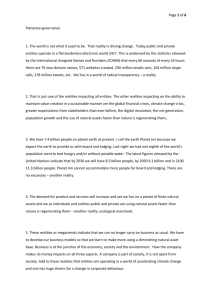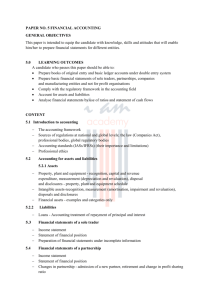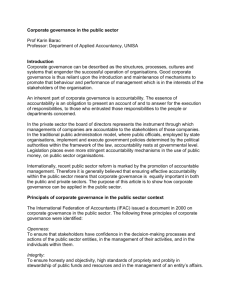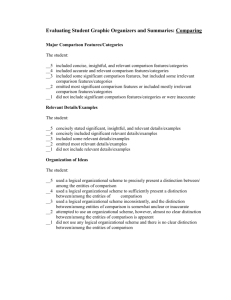CONTENT - Amazon Web Services
advertisement
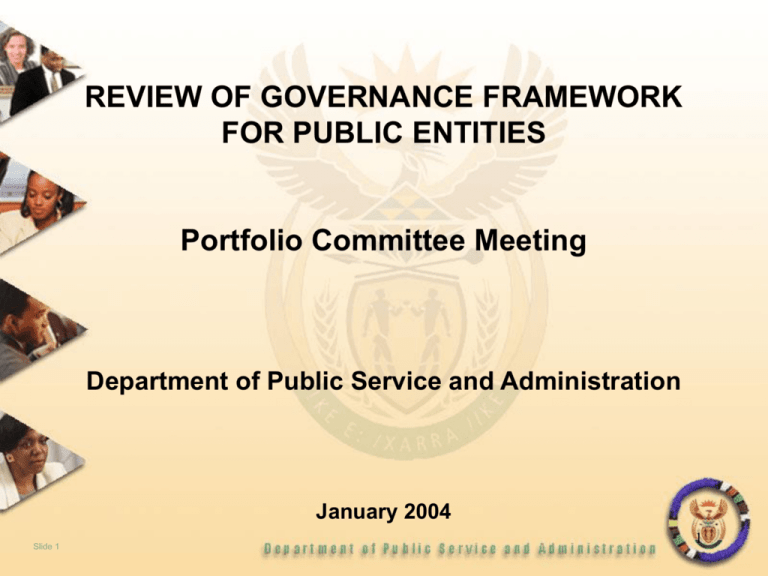
REVIEW OF GOVERNANCE FRAMEWORK FOR PUBLIC ENTITIES Portfolio Committee Meeting Department of Public Service and Administration January 2004 Slide 1 1 CONTENT • Background o Problem Statement o Primary Objectives & Expected Outcomes o Projected Timeframes o Scope • Work Streams • Project Organisation • Progress to Date • Communication Plan & Stakeholder Management • Strategic Impact • Way Forward •Summary Slide 2 • Closure 2 Background: Problem statement After several years of establishing public entities and enterprises to enhance service delivery, government realised the following weaknesses in them: • There are inadequate and inconsistent corporate governance arrangements • Public entities do not always account to the legislature or the executive as expected but to an appointed board • They compromise the existence of single public service as a constitutional requirement making the restructuring of public service to become cumbersome • Public enterprises have made some progress working with DPE but there was potential for improvement ( e.g. Development of a protocol on Corporate Governance) Slide 3 3 Background : Problem statement • Fragmented regulatory frameworks – PEs are established in terms of their Enabling Acts or the Companies Act all with their own requirements – Various corporate forms exist – Trusts, Trading Entities, Section 21, Companies – Remuneration and conditions of service are provided for in Enabling Acts and not the Public Service Act which lead to inconsistent interpretations • Current Classification framework are no longer sufficient to provide for flexible institutional options to support service delivery ( Schedules 3A and 3B of PFMA) • Governance arrangements are ineffective i.t.o – Departments do not attend to managing performance adequately – Inconsistencies in the levels of remuneration of Board members and staff across PEs – Governance arrangements (King Code) are applied differently by PEs – There is little regard for preferential procurement policy which lead to Slide 4 unfair application of tender processes 4 Background: Primary objectives As a result , Cabinet mandated DPSA and NT in 2002 to review governance frameworks of all non-business PEs (Schedule 3A) and GBEs (Schedule 3B). DPSA and NT were also mandated to establish a panel to review all business cases for entities to be developed by departments prior to establishment. DPSA and NT are jointly executing the review project with the following primary objectives: • To design a coherent regulatory framework supported by sound governance practices • To promote unified (not uniform) machinery of government in line with Constitutional values and principles for public administration • To improve knowledge of applicable legislation in public entities The panel to evaluate public business cases is also operational and is comprised of officials from both departments. Slide 5 5 Background: Expected Outcomes After implementation of the recommendations of the project, government expects the following outcomes: • Improve classification framework (Definition, Types) • Assess the role of PEs in their current corporate form – Develop preferred corporate forms - Sect 21 companies, Trusts – Proposals for PEs to evolve to new corporate forms • Improve corporate governance, accounting arrangements and fairness of procurement procedures • Improve Performance Management and HRM – Perf mang corporate level & staff – Grading, remuneration, fringe benefits - board and staff – Collective bargaining arrangements • Review the appropriateness of regulatory frameworks in relation to PEs and propose amendments Slide 6 6 Background: Project Timeframe Phase 1 • Data Gathering • Classification Framework We are here! Phase 2 • Corporate Status • Legislative Review • Corporate Governance • Performance Management & Review Aug 03 Slide 7 Jan 04 May 04 7 Background: Scope 185 entities of total (recorded) 336 where there’s a transfer of funds totaling R15bn National Sphere of Government Government Clusters Organisational Components Head Office Provincial Administrations Regional Office District Office Departments Head Office Exclusive Functional Competencies Public Service 33 Departments Provincial Sphere of Government District Office Regional Office Constitutional Institutions Public Entities National Public Entities Provincial Public Entities Business Enterprises Business Enterprises Major Public Entities Slide 8 Concurrent Functional Competencies 8 Background: Scope The following are the exclusions from the scope of the current project: • Provincial entities will be reviewed following a separate process after liaison with relevant stakeholders. Provincial Directors-General and Treasuries will be requested to conduct complementary reviews of public entities within their provinces. • The provincial process will leverage lessons learnt from the current project • The current project will not cover all entities but will be limited to Schedule 3A (e.g.. SETAs, SITA, Legal Aid Board) and 3B entities (GBEs egg. Water Boards, SABS) • The current project will not focus on the review of individual entities but 9 Slide 9 their overall status quo Work Streams The following are the primary focus of each work stream of the project • Data Gathering, gather data from the whole population under study, collate it and provide preliminary findings. Questionnaires for Departments, Chairmen of controlling bodies of P.Es and CEOs were used as primary tools to gather data. Workshops and interviews were for follow-up. • Classification Framework, gather data on international practices of classification of public entities, analyse the data, workshop with key stakeholders and recommend a new framework • Corporate Status, based on the findings of data gathered and researched best practice, recommend a new framework for corporate status determination • Corporate Governance Review, based on the findings of data gathered and researched best practice, recommend a new framework for corporate governance standard / code • Legislative Review, based on the findings of data gathered and researched best practice, revise the current legislative framework accordingly • Human Resource Management(HRM) and Performance Management(PM) Review, based on the findings of data gathered and researched best practice, determine a new Slide 10 10 policies for HRM & PM Project Organisation Cabinet Ministers: Finance / Public Service and Admin / Governing Ministeries Project Steering Committee Project Manager / Secretariat Phase 1 Phase 2 Classification Framework Legislative Review (1) Corporate Governance (3) Data Collection Teams Corporate Status (2) Performance Management (4) The project is jointly managed between the DPSA/NT with the assistance of local and international service providers in close co-operation with government departments and PEs Slide 11 11 Progress to Date: Phase 1 Phase 1(August 2003 – January 2004) • Data Gathering o data gathering by means of structures questionnaires, interviews and workshops have been completed o a data-set is being finalised o a workshop was held to review the first draft of the findings and analysis o a final report will be submitted and presented to the project steering committee in January 2004 • Classification Framework, o international and local research has resumed o a workshop was held with the steering committee to clarify expectations. o the final report will be delivered in March 2004. • Reports from both the Data Gathering and Classification Framework will input to phase 2 of the project Slide 12 12 Progress to Date: Phase 2 As indicated earlier, consultants have just resumed their duties and thus far they have presented their work-plans. They have been introduced to the service providers of phase 1 for liaison on their work Phase 2 (January 2004 – May 2004) • Corporate Status • Governance • Legislative • Human Slide 13 review Resource Management & Performance Management 13 Progress to Date: Preliminary findings from phase 1 work On the overall the findings are validating the concerns on the public entities. A significant amount of the data have not been analysed and therefore the findings presented below are preliminary: • There seems to be misalignments between departments and their respective public entities on the corporate governance arrangements • There seems to be limited understanding of the legislative framework by some of the controlling bodies and CEOs of public entities • Although there seems to be procurement policies in place, these are mainly not aligned to the Preferential Procurement Policy (PPP) • Some public entities are not clear about their reporting lines and the reporting process they should follow, including frequency etc. • It seems that the strategies of PEs are driven more formally by their enabling legislation rather than performance management and service level agreements 14 • 70 unlisted PEs have been identified and their information is being incorporated Slide 14 Communication Plan & Stakeholder Management • Portfolio Committee, Ministers, Cabinet, MECs and social partners to be kept informed of progress • Project Steering Committee submits findings and proposals through DPSA / NT , and relevant department – to the Executive, and then – to Cabinet for decision making • Slide 15 Provinces will be encouraged to undertake similar exercise 15 Strategic Impact • Good corporate governance in Public Entities enables improved service delivery in line with Batho Pele principles • Public Entities with good corporate governance are better placed to deliver on other government priorities such as poverty alleviation • Compliance to international practices will lead to improved assessment of the S.A economic status by global bodies (e.g. International Monetary Fund). This can result in improved rankings and help attract Foreign Direct Investment. • Achievement of these is a step towards fulfillment of NEDLAC commitments in relation to the Growth and Development Summit (GDS) by Government. Slide 16 16 Way Forward • Follow-up communication sessions with key stakeholders on progress and deliverables • Interrogation of deliverables • Closure report at the end of the project • Encouraging provincial governments to review of Provincial entities in co-operation with provincial stakeholders Slide 17 17 Summary • The primary objectives of the review project is to design a coherent regulatory framework and establish the required institutional mechanisms to support service delivery. • The outcomes of the review would contribute to improving – the regulatory framework that governs PEs – the oversight of Government over PEs; and – The corporate governance of entities including performance management, human resource practices, accounting arrangements and fairness of procurement procedures Slide 18 18 Q & A Session Slide 19 19




